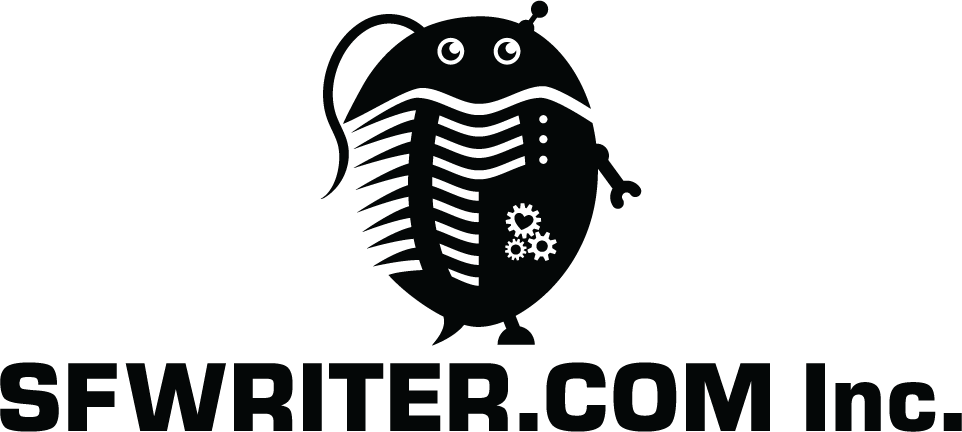![Robert J. Sawyer [Robert J. Sawyer]](rjssmhd.jpg) Science Fiction Writer
Science Fiction Writer
ROBERT J. SAWYER
Hugo and Nebula Winner
SFWRITER.COM > Novels > Frameshift > Book Club Guide
vspace=10 height=70 alt="[FRAMESHIFT spine]">
Book Club Guide
FRAMESHIFT
by Robert J. Sawyer
Many reading groups and book clubs have enjoyed novels by Robert J. Sawyer. The following questions may help stimulate an interesting discussion about Frameshift. (These questions might also suggest essay topics for students studying the book.)
Email Rob with a list of the first names of the members of your book club, the title of the book by him your club is reading, and one postal address, and Rob will send you personally autographed bookplates for every member of your group. (Bookplates are self-adhesive labels you can put inside your own copy of a book — they're free and they're fun!)
attractive brochure format suitable for
printing as an Adobe Acrobat PDF file.
Note that these questions reveal much of the novel's plot; to preserve your reading pleasure, please don't look at these questions until after you've finished reading the book.
- The case of John Demjanjuk really happened as outlined in
Frameshift. With the exception of Avi Meyer, all
the characters portrayed in the Jerusalem trial scene are real
people, saying things they actually said during the trial. Is it
appropriate to blend fact and fiction like this? And are the
parallels Sawyer raises between the Demjanjuk trial and both
To Kill a Mockingbird and Judgment at
Nuremberg fair? Likewise, how appropriate was Sawyer's
invoking, elsewhere in the novel, Martin Luther King's "I have
a dream" speech?
- The novel makes the case that it is in fact cruel to
diagnose
someone with the gene for a serious genetic disorder that hasn't
yet manifested itself if there's nothing that can be done to
prevent the onset of the disease. Would you in fact want to know
if you had the gene for Huntington's disease?
- Sawyer seems to believe strongly that socialized medicine is
the
only solution that makes sense in the genetic age. Do you agree
or disagree with him? Why?
- A few critics have suggested that Sawyer is unfair to men in
this
book, since the isolated glimpses of some of their minds that we
see through Molly's telepathy are quite distasteful. Does
Sawyer's take on men's private thoughts about women ring true?
- The novel's structure is unusual: it starts with neo-Nazi
Chuck
Hanratty's attack on Pierre Tardivel, and then about half the
book is a series of flashbacks, going as far back as 1944,
leading up to that event. Was this an effective way to structure
the book? In interviews, Sawyer has
said he tried drafting it three different ways: (1) in straight
chronological order, starting with the Treblinka scene, and
without the Hanratty attack occurring until its natural point in
the narrative; (2) with the Treblinka scene as a prologue
preceding the attack by Hanratty; and, (3) as presented in the
final book, beginning with the attack, then flashing back to
Treblinka. Did Sawyer choose the most effective sequence? On a
related note, there are chapters that were cut from the novel
detailing Pierre and Molly's lives before they met; the full text
of these chapters is on Sawyer's web site at
www.sfwriter.com/frlc.htm.
Was he right to cut these chapters?
- Frameshift has several different plot elements:
the Treblinka / Demanjuk arc; the Klimus and Amanda-clone arc; the
insurance-company arc; Pierre's Huntington's disease; Molly's
telepathy; and the discovery of a new layer of information coded
in our DNA. Do you think they intertwine well? Were all of them
necessary? (Hint: see the Frameshift structural
analysis on Sawyer's web site at
www.sfwriter.com/frstruct.htm
for the author's own take on this question.)
- Molly wanted to marry Pierre despite knowing that he would
become extremely disabled in only a few years. Would you have
made the same choice Molly did?
- The novel touches on some of the moral quandaries raised by
human cloning, in particular the question of who owns a clone. What
impact do you think the ability to create clones will have on
society? Should human cloning be banned?
- Many readers assumed that because Pierre is a geneticist, he
will find a cure for Huntington's disease before the novel is
over, thereby saving himself. This doesn't happen. Did Sawyer
make the right decision? Is the end of the book a downer or is
it uplifting?
- There's a religious subtext to the novel, especially in the notion that the broad strokes of humanity's development had been planned out by a creator. Can the hard scientific worldview portrayed in the novel ever be reconciled with matters of faith?
More Good Reading
Download this Book Club Guide in Adobe Acrobat Format
More about Frameshift
Book Club Guide Index
Book Club Guide for The Oppenheimer Alternative
Book Club Guide for Quantum Night
Book Club Guide for Triggers
Book Club Guide for Wake
Book Club Guide for Rollback
Book Club Guide for Mindscan
Book Club Guide for Hominids
Book Club Guide for Calculating God
Book Club Guide for FlashForward
Book Club Guide for Factoring Humanity
Book Club Guide for Illegal Alien
Book Club Guide for The Terminal Experiment
Book Club Guide for End of an Era
Book Club Guide for Golden Fleece
My Very Occasional Newsletter
Copyright © 1995-2024 by Robert J. Sawyer.
